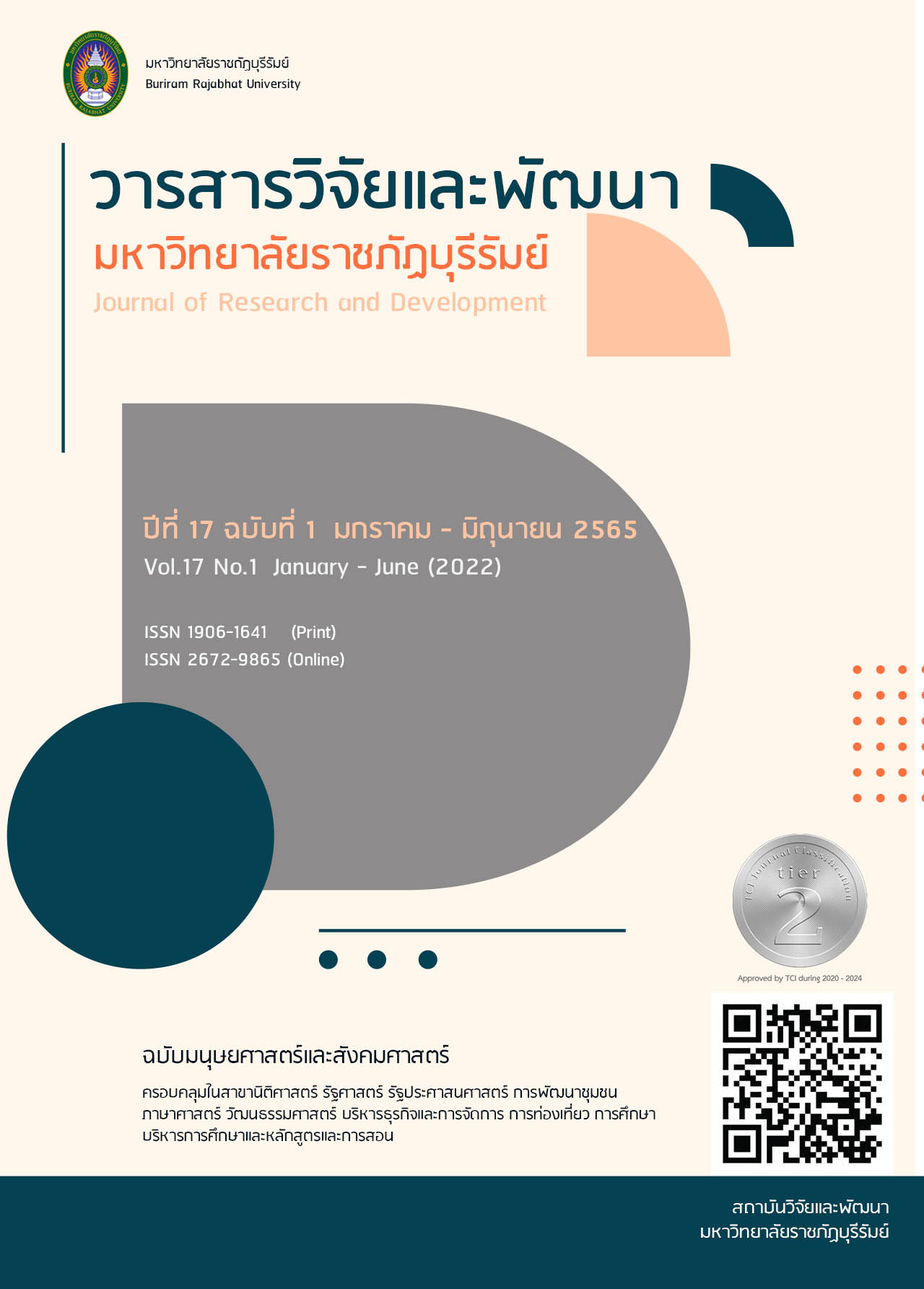ปัจจัยด้านการตลาดดิจิทัลที่มีอิทธิพลต่อพฤติกรรมการซื้อผลิตภัณฑ์ สกินแคร์ของผู้บริโภคในกรุงเทพมหานครและปริมณฑล
Main Article Content
บทคัดย่อ
สื่อดิจิทัลถือเป็นเครื่องมือในการทำการตลาดที่สำคัญสำหรับอุตสาหกรรมสกินแคร์ในการดึงดูดผู้บริโภค ดังนั้น การวิจัยครั้งนี้จึงมีวัตถุประสงค์เพื่อ ศึกษาปัจจัยด้านการตลาดดิจิทัลที่มีอิทธิพลต่อพฤติกรรมการซื้อผลิตภัณฑ์สกินแคร์ของผู้บริโภคในกรุงเทพมหานครและปริมณฑลด้วยทฤษฎีพฤติกรรมตามแผน (TPB) ทำการเก็บรวบรวมข้อมูลโดยการแจกแบบสอบถามแก่ผู้บริโภคอายุระหว่าง 20 – 40 ปี จำนวน 400 คน และวิเคราะห์ข้อมูลด้วยสถิติเชิงพรรณนา ได้แก่ ร้อยละ T-test, F-test และสมการถอดถอย ผลการศึกษา พบว่า ทัศนคติต่อการใช้สื่อดิจิทัล กลุ่มอ้างอิง และความสามารถในการใช้สื่อดิจิทัล เป็นปัจจัยที่มีอิทธิพลต่อพฤติกรรมการซื้อของผู้บริโภคอย่างมีนัยสำคัญที่ระดับ 0.01 ซึ่งผลจากการศึกษาจะสามารถเป็นแนวทางด้านทฤษฎีและปฏิบัติแก่นักการตลาดสำหรับกิจกรรมด้านการทำการตลาดดิจิทัลต่อไป
Article Details

อนุญาตภายใต้เงื่อนไข Creative Commons Attribution-NonCommercial-NoDerivatives 4.0 International License.
เนื่อหาและข้อมูลในบทความ เป็นความรับผิดชอบของผุ้แต่ง
บทความในวารสารเป็นลิขสิทธิ์ของวารสารวิจัยและนวัตกรรมท้องถิ่น
เอกสารอ้างอิง
กิติชัย ศรีสุขนาม (2564). “ความสัมพันธ์เชิงสาเหตุของกลยุทธ์การตลาดดิจิทัลที่ส่งผลต่อการตัดสินใจซื้อสินค้าประเภทอิเล็กทรอนิกส์ของผู้บริโภคกลุ่มมิลเลนเนียล (Gen M: Millennials).” วารสารศรีนครินทรวิโรฒวิจัยและพัฒนา (สาขามนุษยศาสตร์และสังคมศาสตร์). 13(26) : 1-19.
นิตยสารอิเล็กทรอนิกส์ Positioning. (2562). “Headline: โฆษณาดิจิทัลปีนี้ทะลุ 2 หมื่นล้าน “เฟซบุ๊ก-ยูทูบ” โกยเม็ดเงินครึ่งตลาด.” สืบค้นเมื่อ 17 มีนาคม 2563, จาก https://positioningmag.com/1244465
ศิวัตร เชาวรียวงษ์. (2563). “Future of Marketing: การตลาดดิจิทัล อาวุธโลกธุรกิจหลังโควิด-19.” สืบค้นเมื่อ 19 ตุลาคม 2563, จาก https://www.scb.co.th/
th/personal-banking/stories/business-maker/future-of-marketing.html
สมาคมโฆษณาดิจิทัลประเทศไทย. (2562). “Digital ad spend.” สืบค้นเมื่อ 27 มีนาคม 2563, จาก https://www.daat.in.th/digital-ad-spend
สำนักงานสถิติแห่งชาติ. (2563). “สถิติประชากรศาสตร์ ประชากรและเคหะ.” สืบค้นเมื่อ 28 มีนาคม 2563, จาก http://statbbi.nso.go.th/staticreport/
page/sector/th/01.aspx
Ajzen, I. (1991). Organizational Behavior and Human Decision Process: The Theory of Planned Behavior. Massachusetts : Academic Press. Inc.
Ameen, N., Tarhini, A., Shah, M. H., & Madichie, N. (2020). “Employees’ behavioural intention to smartphone security: A gender based, cross-national study.” Computers in Human Behavior. 104(1) : 1-14.
Bai, Y., Yao, Z., & Dou, Y.-F. (2015). “Effect of social commerce factors on user purchase behavior: An empirical investigation from renren.com.” International Journal of Information Management. 35 : 538-550.
Chaffey, D. & Smith, PR. (2017). Digital Marketing Excellence Planning, Optimizing and Integrating Online Marketing. New York : Taylor & Francis.
Dahiya, R. & Gayatri. (2017). “A Research Paper on Digital Marketing Communication and Consumer Buying Decision Process: An Empirical Study in the Indian Passenger Car Market.” Journal of Global Marketing. 31(2) : 73 – 95.
Fishbein, M., & Ajzen, I. (1975). Belief, Attitude, Intention, and Behavior: An Introduction to Theory and Research. Reading. MA : Addison-Wesley.
Holdbrook, M. B. (1985). “Why business is bad for consumer research: the three bears revisited.” Advances in Consumer Research. 12 : 145-156.
Kotler, P., & Armstrong, G. (2020). Marketing : An Introduction. New Jersey : Prentice Hall.
Kotler, P., Kartajaya, H. & Setiawan, I. (2016). Marketing 4.0 Moving from Traditional to Digital. New Jersey : John Wiley & Sons, Inc.
Lee, J., & Hong, I. B. (2016). “Predicting positive user responses to social media advertising: The roles of emotional appeal, informativeness, and creativity.” International Journal of Information Management. 36(1) : 360-373.
Lodhi, S., & Shoaib, M. (2017). “Impact of E-marketing on consumer behaviour: A case of Karachi, Pakistan.” Journal of Business and Management. 19(1) : 90-101.
Minbashrazgah, M. M., Maleki, F., & Torabi, M. (2017). “Green chicken purchase behavior: the moderating role of price transparency.” Management of Environmental Quality: An International Journal. 28(6) : 902-916.
Nizar, N. A. & Janathanan, C. (2018). Impact of digital marketing on consumer purchase behavior: A case study on Dialog Axiata with specific reference to social media marketing. In “APIIT Business, Law & Technology Conference” (p. 1-11). Colombo: Sri Lanka.
Ranjbarian, B., Rehman, M. & Lari, A. (2014). “Attitude Toward SMS Advertising and Derived Behavioral Intension, An Empirical Study Using TPB (SEM Method).” Social Economic Debates. 3(1) : 42-59.
Sembada, A. Y. & Koay, K. Y. (2021). “How perceived behavioral control affects trust to purchase in social media stores.” Journal of Business Research. 130 : 547-582.
Shadkam, M. (2017). “Consumer’s attitude to receive and response to SMS advertising.” International Journal of Business Information System. 24(1) : 69-90.
Smith, K. T. (2011). “Digital marketing strategies that Millennials find appealing, motivating, or just annoying.” Journal of Strategic Marketing. 19(6) : 489–499.
Solomon, M. (2009). Consumer Behavior: Buying, having and being (8th ed). New Jersey : Pearson Education.
Wilson, N., Theodorus, E., & Tan P. (2017). “Analysis of Factors Influencing Green Purchase Behavior: A Case Study of The Cosmetics Industry In Indonesia.” Jurnal Muara Ilmu Sosial, Humaniora, dan Seni. 1(2) : 453-464.
Wu, S. I., & Chan, H. J. (2011). “Perceived service quality and self-concept influences on consumer attitude and purchase process: A comparison between physical and internet channels.” Total Quality Management. 22(1) : 43 –62.
Yamane, T. (1973). Statistics: An Introductory Analysis. (3rd ed.). New York : Harper and Row.


